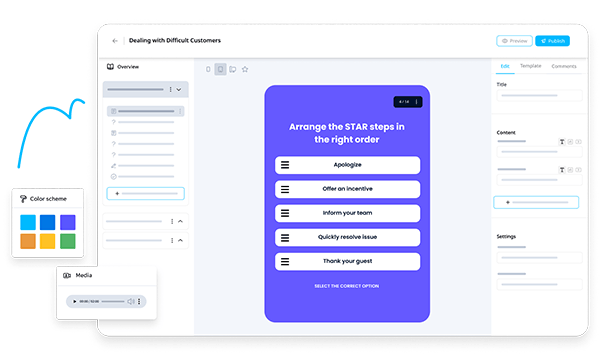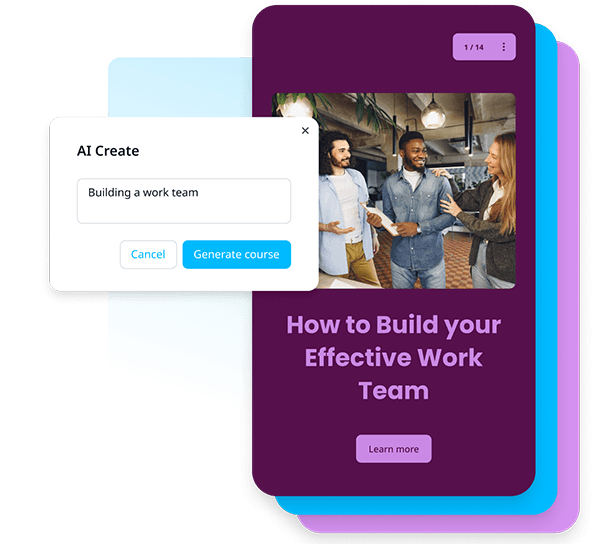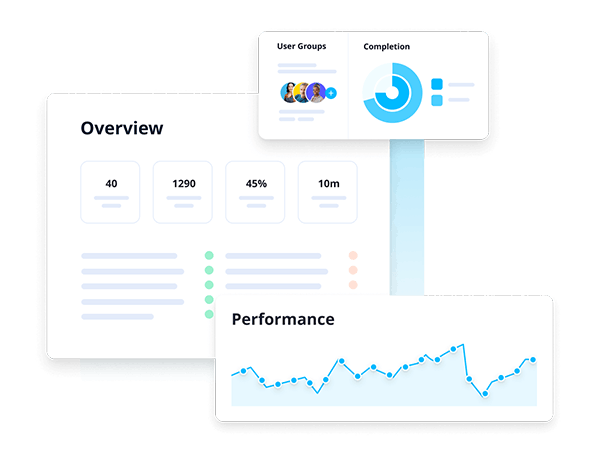Employee Training Plan: Investing in Growth

If you don't have a proper employee training plan in place, your training efforts are likely to fall flat. On the other hand, having a well-designed training plan can really boost the growth, development, and engagement of your team, and it has the potential to make your organization even stronger.
What is an employee training plan?
To break it down for you, an employee training plan is basically a document that spells out all the important stuff about a training program. It's like a roadmap that tells you what the training aims to achieve, what employees will learn, and how they'll be taught.

This plan covers everything from the goals of the training to the specific skills and knowledge employees will gain. It also outlines the different training methods and strategies that will be used, as well as the actual curriculum that will be followed. In a nutshell, it’s a blueprint for training employees throughout the entire organization.
Here are the basic components that you should include in your training plan:
- Target audience
- Topics or content
- Learning or training objectives
- Type of training
- Training timeline
- Training location (if applicable)
- Training method
- Training tools and sources
Types of employee training plans
When it comes to employee training plans, they can actually differ quite a bit depending on the industry you're in and the type of job you have. But, in general, they tend to fit into three main categories.
New hire training plans
When training new hires, the main goal is to give them all the skills they need to get the job done effectively. This can include things like setting goals with their direct supervisor, building up their skills, and looking at long-term development.

Now, these training plans can be tailored to each specific job role. Let's say you have a new customer service employee joining the team. While some aspects of their training may overlap, they'll also have tasks and responsibilities that are unique to their respective roles. For example, if your company has mandatory DEI training for all new hires, your new hires need to take that course in addition to their job-specific training.
Growth and development plans
As managers or human resource personnel, it's important to be proactive in helping your team members develop and acquire new skills and competencies that align with their career goals. These plans can be either short-term or long-term, but the main idea is to prepare them to further their growth and take the next big step, whether it's a promotion or a lateral move.

The cool thing is that you can design these employee development plans to match the company's broader goals. And here's the best part—they can also be super customized to fit each team member’s specific job role.
Safety training plans
Safety training plans are essential in giving your employees the skills and knowledge they need to carry out their tasks in a safe manner. Usually carried out throughout the organization, these training plans go beyond just general safety awareness. You can use them to give specific instructions and guidelines to help your team identify, report, and handle workplace hazards and incidents.

And let's face it, accidents can still occur sometimes, so this training also equips them with the know-how to deal with injuries if they happen.
Safety training plays a crucial role in making sure that employees are well aware of and follow the necessary safety protocols in various situations, like dealing with fires or workplace accidents.
Here are some common types of employee training programs that you should take note of for your training plans:
Benefits of employee training plans
Employee training plans are like secret weapons that can help you bring order and structure to your organization's employee development efforts. When you have these training plans in place, you can standardize the way you train your employees. It means everyone gets a fair shot at growth and learning.
To break it down further, an employee training plan also:
- Encourages consistency - Having a well-designed employee training plan brings consistency to the way training is delivered throughout your organization. It creates a cohesive workforce that can consistently deliver top-notch performance and achieve outstanding outcomes. When everyone is equipped with the same level of training, it's the entire organization operates in sync, delivering high-quality results every time.
- Improves compliance and safety - In certain industries where compliance is an absolute must, having a training plan can help you meet strict regulatory requirements. It also protects you and your team from potential compliance risks, legal troubles, damage to your reputation, and those dreaded financial penalties.
- Increases employee engagement - Implementing employee training plans can foster the development of a company culture that prioritizes learning. By acquiring fresh skills and competencies, team members can improve their ability to make a more significant contribution. That’s why this results in improved performance, heightened engagement, and better retention rates.
- Reduces skill gaps - Employee training plans can be your trusty sidekick when it comes to tackling knowledge gaps in your workforce. They can help you bring some much-needed structure to the table by introducing intentional upskilling programs.
Steps to create an effective employee training plan
Here are five steps that you can take to build an effective and engaging employee training plan:
1. Determine training needs and knowledge gaps
Before diving headfirst into your employee training plan, you’ve got to make sure that you conduct a proper training needs analysis. Why is it so crucial, you ask? Well, it can help you develop top-notch training materials without wasting time and resources.

By determining what skills are lacking, you’ll have an easier time understanding what kind of training will do the trick. You can do some research, conduct interviews, run internal surveys, and keep a close eye on previous training performance. Once you have the answers, you can tailor your employee training plan to meet the learning needs of your team.
2. Set training objectives
Picture this: an employee training plan that's packed with both short-term and long-term goals that can actually be measured. You must be able to set clear outcomes that employees are expected to achieve once they've completed their training program. They should be designed to grab employees' attention and get them excited about the real benefits they'll gain.

Now, when it comes to setting these training objectives, you gotta keep things in check. Metrics are the name of the game here. This can include elements like quantity, quality, time, cost, and effectiveness.
3. Choose training methods
Once you've figured out what you want to achieve with your training and have a good understanding of what your learners need, the next step is to decide how you want to deliver the training. When selecting the right training methods, it's important to consider the nature of the content, the learning preferences of your employees, and the available resources. By taking these factors into account, you can make an informed decision that suits your needs.

There’s a variety of methods you can choose from, depending on what works best for your situation. Here’s a quick rundown of a few options:
- Instructor-led session - This is when a trainer stands in front of a group of learners in a physical classroom setting and delivers the content directly to them. It's a great way to have face-to-face interaction and engage with the learners directly.
- Online training - This method uses electronic platforms like online courses, virtual classrooms, or interactive multimedia modules to deliver the training content. It's convenient because learners can access the materials from anywhere, at any time.
- Blended learning - If you're looking to combine the benefits of in-person interaction and the flexibility of online learning, you might want to consider this approach. It involves a mix of face-to-face sessions and online components, allowing learners to get the best of both worlds.
- Self-paced learning - This method puts the responsibility on the learners themselves. They can read and access the training materials at their own pace, based on their specific needs and interests. It's a great choice if you have learners who prefer more autonomy in their learning process.
4. Create and implement your training plan
When it comes to training, creating engaging training materials can come a long way in making sure every team member understands and retains knowledge. So, think about making presentations that really grab attention, videos that teach in a fun and interactive way, and cool e-learning courses that keep learners engaged.

The key here is to make sure your training programs match your goals and meet the specific needs of your learners. And hey, visuals matter! Make your materials visually appealing, easy to understand, and accessible to everyone.
Investing in an employee training platform like EdApp can be a game-changer for you! It gives you the power to create and assign training courses to all the employees with just a few clicks. You can take advantage of its Creator Tool to build training courses from scratch or try out its latest AI Create feature to generate fully packaged training content in seconds.

Once you’ve got your learning materials ready, you can go ahead and send the course straight to your employee’s mobile devices.
5. Evaluate your employee training plan
Once you've finished your training, it’s important to figure out how effective it actually was. And to do that, you need to conduct evaluations. You can use things like pre- and post-training assessments, feedback surveys, and performance evaluations to get a real good sense of how the training went down.

Take a good look at the results and see what areas could use some improvement. This way, you can make the necessary tweaks and adjustments for your future training plans. With EdApp's built-in reporting and analytics dashboards, you can keep an eye on how everyone is progressing on their courses, track completion rates, and evaluate overall performance.
Create an effective employee training plan and invest in your team’s growth. Sign up with EdApp today!
Author
Hannah Malmstrom
Hannah is an eLearning writer who dedicates her time to creating in-depth content about EdApp, a multi-award-winning mobile LMS that has pioneered one of the most progressive microlearning solutions on the market. She brings years of writing experience in the online software industry to her current role in the eLearning sphere. When she's not writing, you can find her catching up on new anime series or re-reading her favorite novels.
